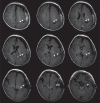Which is the most appropriate disconnection surgery for refractory epilepsy in childhood?
- PMID: 24140769
- PMCID: PMC4508717
- DOI: 10.2176/nmc.oa2013-0111
Which is the most appropriate disconnection surgery for refractory epilepsy in childhood?
Abstract
Children with unilobar or multilobar pathology issuing in refractory epilepsy are potential candidates for surgical treatment. Extensive surgery results in good seizure control, but it also increases the risk of neurological deficits as well as motor and mental problems. We reviewed the cases of 19 children with refractory epilepsy treated surgically at Osaka University Hospital. Four of the 19 patients underwent temporal disconnection, 2 underwent occipital lobectomy, 4 underwent temporoparietooccipital disconnection, 6 underwent functional hemispherotomy, and 3 underwent corpus callosotomy. A good surgical outcome, i.e., Engel's class I or II, was achieved in 12 (63%) of the 19 patients. Excellent surgical outcomes and satisfactory motor and mental development were achieved in 4 patients who underwent temporoparietooccipital disconnection. The outcomes of functional hemispherectomy were also satisfactory. The outcomes of temporal disconnection and corpus callosotomy were poor in comparison to outcomes of the other procedures. We believe that better surgical outcomes would have been achieved with temporoparietooccipital disconnection in some cases treated by temporal disconnection or occipital resection. Adequate extensive surgical procedures should be considered for refractory childhood epilepsy arising from unilobar or multilobar pathology.
Conflict of interest statement
None of the authors have personal, financial, or institutional interest in any of the drugs, materials, or devices noted herein. Those who are members of the Japan Neurosurgical Society (JNS) have registered online Self-reported COI Disclosure Statement Forms through the JNS website.
Figures
References
-
- Chabardès S, Minotti L, Hamelin S, Hoffmann D, Seigneuret E, Carron R, Krainik A, Grand S, Kahane P, Benabid AL: [Temporal disconnection as an alternative treatment for intractable temporal lobe epilepsy: techniques, complications and results]. Neurochirurgie 54: 297– 302, 2008. (French) - PubMed
-
- Cook SW, Nguyen ST, Hu B, Yudovin S, Shields WD, Vinters HV, Van de Wiele BM, Harrison RE, Mathern GW: Cerebral hemispherectomy in pediatric patients with epilepsy: comparison of three techniques by pathological substrate in 115 patients. J Neurosurg 100 ( 2 Suppl Pediatrics): 125– 141, 2004. - PubMed
-
- D'Agostino MD, Bastos A, Piras C, Bernasconi A, Grisar T, Tsur VG, Snipes J, Juhasz C, Chugani H, Guerrini R, Cross H, Andermann E, Dubeau F, Montes J, Olivier A, Andermann F: Posterior quadrantic dysplasia or hemi-hemimegalencephaly: a characteristic brain malformation. Neurology 62: 2214– 2220, 2004. - PubMed
-
- Daniel RT, Meagher-Villemure K, Farmer JP, Andermann F, Villemure JG: Posterior quadrantic epilepsy surgery: technical variants, surgical anatomy, and case series. Epilepsia 48: 1429– 1437, 2007. - PubMed
-
- De Ribaupierre S, Delalande O: Hemispherotomy and other disconnective techniques. Neurosurg Focus 25: E14, 2008. - PubMed
MeSH terms
Substances
LinkOut - more resources
Full Text Sources
Other Literature Sources
Medical


